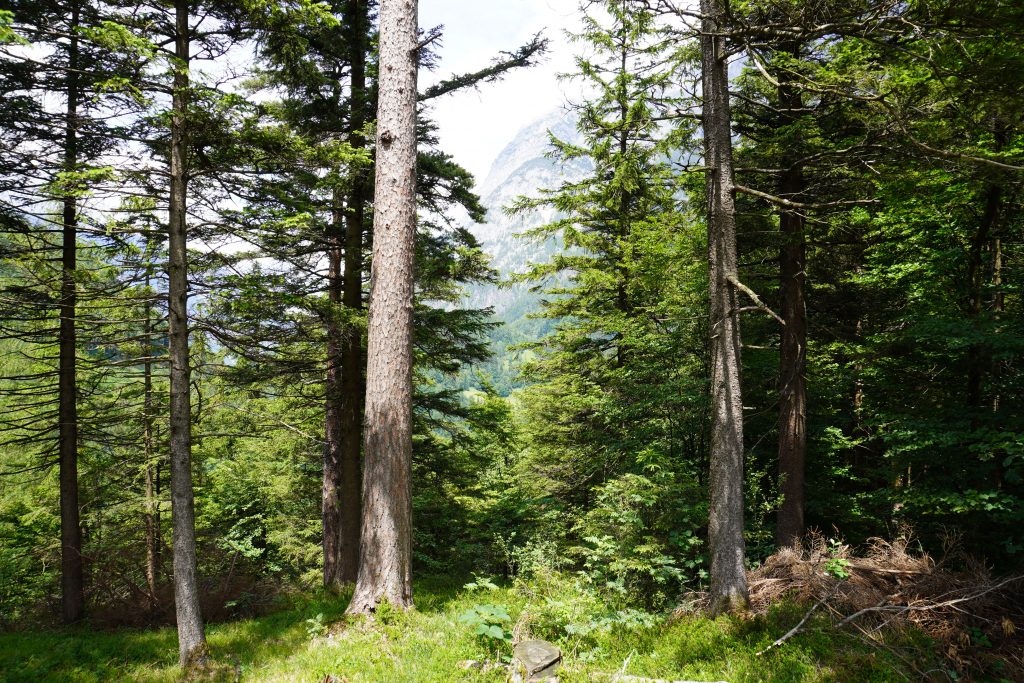DI Alexandra Freudenschuß ist Forstwirtin und seit 2014 am Institut für Waldinventur am Bundesforschungszentrum für Wald (BFW) tätig. Das BFW forscht an sechs Fachinstituten und zwei forstlichen Ausbildungsstätten u.a zu den Thematiken Waldgenetik, Waldschutz und Waldaufbau.
Was ist Klima-Kultur für Sie?
So schwer es auch manchmal fällt, wir müssen es als Gesellschaft schaffen unsere Lebens- und Wirtschaftsweise zu ändern. Hin zu nachhaltig ressourcenschonend sowie raus aus den fossilen Rohstoffen. Dann wären wir aus meiner Sicht auf einem guten Weg zu einer „Klima-Kultur“.
Warum ist es so wichtig sich für unser Klima einzusetzen?
Die Folgen der Klimaerwärmung sind weltweit sichtbar – häufigere Stürme und Hochwässer, längere Dürreperioden mit weitreichenden sozialen, ökologischen und ökonomischen Auswirkungen. Wir müssen im Klimaschutz endlich aktiv werden und Maßnahmen zur Erreichung der Klimaziele konsequent umsetzen. Nur dann haben wir eine Chance, unser Leben und das unserer nachfolgenden Generationen zu sichern.
Was kann jeder einzelne/ jede einzelne für mehr Klima-Kultur tun?
Ich bin überzeugt, dass jeder und jede im Alltag einen Beitrag für mehr Klima-Kultur leisten kann. Die Möglichkeiten sind vielfältig: bewusst regional und biologisch einkaufen, klimafreundliche Mobilität wählen, erneuerbare Energiequellen nutzen. Die Verantwortung darf aber nicht zur Gänze auf Einzelne abgewälzt werden, sondern muss auch wesentlich von der Politik und Wirtschaft mitgetragen werden.
Gelebte Klima-Kultur: „CareforParis“
Wald und Holz sind wichtige Player im Klimaschutz: Wald nimmt Kohlendioxid (CO2) aus der Luft auf und speichert den Kohlenstoff (C) im Holz. Gleichzeitig benötigt der Wald aber auch Klimaschutzmaßnahmen, denn die Folgen des Klimawandels verringern die C-Speicherfähigkeit.
Im Projekt „CareforParis“ wurden verschiedene Szenarien der Waldbewirtschaftung erstellt und ihre Entwicklungen bis ins Jahr 2150 untersucht. Die Szenarien beinhalten unterschiedliche Klimaveränderungen und Anpassungsstrategien: Die CO2-Bilanz des Waldes, die CO2-Bilanz der Holzprodukte und die Vermeidung von CO2-Emissionen durch den Einsatz von Holzprodukten fassen die Ergebnisse zusammen. Die Verwendung von Holz als Ersatz für fossile Rohstoffe ist ein wichtiger Hebel für den Klimaschutz. Nur so kann vermieden werden, dass zusätzliches CO2 aus fossilen Quellen in die Atmosphäre emittiert wird. Österreichs Wald wird zusammen mit den Holzproduktepools wahrscheinlich noch für die nächsten 20 bis 90 Jahre eine CO2-Netto-Senke darstellen. Danach wird er zur CO2-Netto-Emissionsquelle, weil unter den gewählten Annahmen der Zuwachs langfristig wegen schlechterer Wuchsbedingungen, steigendem Schadholzanfall und vorzeitiger Nutzung oder Überalterung zurückgeht und dadurch auch der Vorrat der C-Speicherfähigkeit abnimmt.
Wenn wir das Klimaziel von Paris erreichen wollen, hat die Vermeidung von Treibhausgasemissionen oberste Priorität.
CareforParis ist ein vom Klima- und Energiefond gefördertes Projekt an dem das Bundesforschungszentrum für Wald (BFW), die Universität für Bodenkultur (BOKU), Wood K plus und das Umweltbundesamt zusammenarbeiteten.

#6 Alexandra Freudenschuß to Climate Culture…
DI Alexandra Freudenschuß is a forester and since 2014 at the Institute for Forest Inventory at the Austrian research centre for Forest (BFW). The BFW conducts research at six specialist institutes and two forestry training centres on topics such as forest genetics, forest protection and forest structure.
What does climate culture mean to you?
As difficult as it sometimes, we have to manage our living and change the way we do business. Towards sustainable resource conservation and out of the fossil raw materials. Then, in my view, we would be on the right track towards a “climate culture”.
Why is it so important to work for our climate?
The consequences of global warming are visible worldwide – more frequent storms and floods, longer periods of drought with far-reaching social, ecological and economic effects. We must finally become active in climate protection and take measures to achieve of the climate targets. Only then will we have a chance to save our lives and of our future generations.
What can each individual/individual do for more climate culture?
I am convinced that everyone can contribute to more climate culture in everyday life. The possibilities are manifold: consciously buying regional and organic products, climate-friendly mobility, using renewable energy sources. But the burden of the crisis cannot be shifted on to individuals alone. It must also be supported to a high degree by politics and business.
Living Climate Culture: CareforParis
Forests and wood are important players in climate protection: forests remove carbon dioxide (CO2) from the airand stores the carbon (C) in the wood. At the same time, the forest also needs Climate protection measures because the consequences of climate change reduce the C storage capacity.
In the “CareforParis” project, various scenarios of forest management were created and their developments up to the year 2150. The scenarios include different Climate change and adaptation strategies: The CO2 balance of the forest, the CO2 balance of wood products and the avoidance of CO2 emissions through the use of wood products summarize the results. The use of wood as a substitute for fossil raw materials is an important lever for climate protection. This is the only way to prevent additional CO2 being emitted into the atmosphere from fossil sources. Together with the wood product pools, Austria’s forests will probably continue to be a net CO2 sink for the next 20 to 90 years. After that it will become a CO2 net emission source, because under the chosen assumptions, growth will decline in the long term due to poorer growth conditions, increasing amounts of damaged wood and premature use or overaging, and thus also the saving capacities will decrease.
If we want to achieve the Paris climate target, the avoidance of greenhouse gas emissions has top priority.
CareforParis is a project supported by the Climate and Energy Fund in which the Austrian research centre for Forest F(BFW), the University of Natural Resources and Applied Life Sciences (BOKU), Wood K plus, and the Federal Environment Agency worked together.


